Пн - Сб: с 9 утра до 7 вечера Воскресенье закрыто
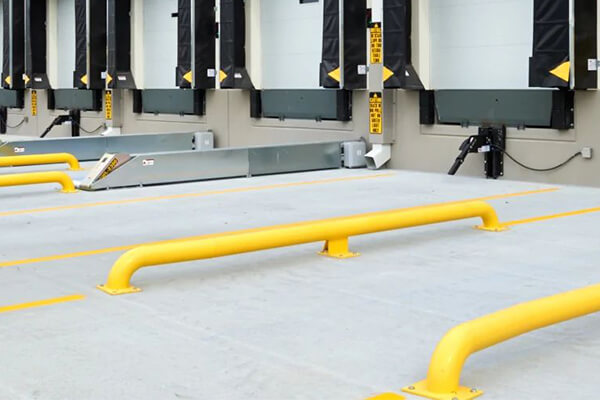
On the busy loading dock, forklifts shuttle between the warehouse and parked trailers, ensuring the efficient flow of goods. However, behind the smooth operation lies a hidden safety hazard — the slight movement of the trailer. When the forklift enters or exits the trailer, it may inadvertently push the trailer, causing the small gap to gradually widen and eventually leading to a serious accident. In this guide, we will provide a comprehensive guide of how trailer restraint system work, the main types, and how to choose the system that best suits your needs. This will help you better understand the advantages of trailer restraint systems and make an informed decision.
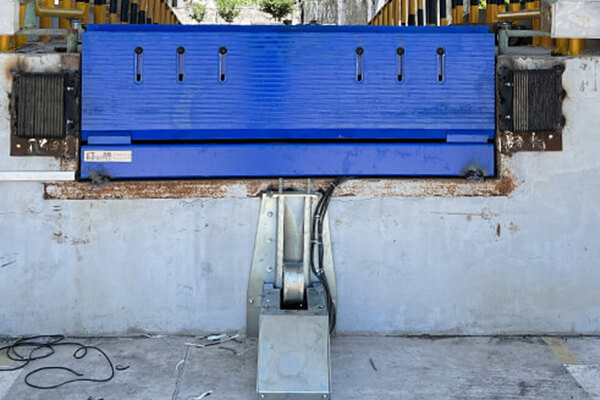
Contents
- 1 The Hidden Danger at the Loading Dock
- 2 What is a Trailer Restraint System and Why is it Critical?
- 3 How Trailer Restraint Systems Work
- 4 The Main Types of Trailer Restraint Systems: Finding the Right Fit for Your Dock
- 5 Key Benefits of Investing in a Trailer Restraint System
- 6 How to Choose the Right Trailer Restraint System for Your Facility
- 7 Часто задаваемые вопросы
- 8 Further Reading: Build a Complete Loading Dock Ecosystem
The Hidden Danger at the Loading Dock
Did you know that industry reports indicate that approximately 25% of warehouse accidents occur at loading docks? The causes of these accidents may seem simple but are highly dangerous: semi-trailers moving uncontrollably during loading and unloading. This danger manifests in two primary forms:
- Trailer Creep: This occurs when the trailer slowly moves away from the loading platform as the forklift enters and exits. When the gap becomes large enough, the platform adjustment plate loses support, potentially causing the forklift and cargo to fall.
- Premature Departure: Due to communication errors, the truck driver may depart the trailer prematurely before loading or unloading operations are complete, placing forklift operators in extreme danger.
To address these risks, modern logistics and warehousing facilities require safer and more reliable solutions — trailer restraint systems. Unlike traditional equipment, trailer restraint systems actively and securely lock the trailer in place, ensuring it does not move unexpectedly throughout the loading and unloading process. Additionally, an integrated signal light system helps maintain clear communication between drivers and warehouse personnel, further enhancing safety.
What is a Trailer Restraint System and Why is it Critical?
The trailer restraint system is a ‘safety lock’ for your loading dock leveler. A trailer restraint system is a mechanical or powered device installed on the outside of dock levelers, specifically designed to securely hook onto a truck trailer to prevent it from accidentally moving during loading and unloading. By actively securing the trailer’s position, it ensures safety during forklift operations.
The Necessity Beyond Traditional Wheel Chocks
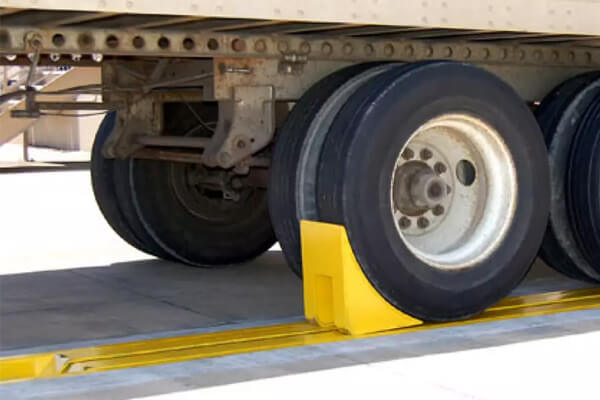
Traditional wheel-based restraints can temporarily prevent trailer movement, but they have significant limitations: they are easily misplaced, forgotten, and may fail in adverse weather conditions. In contrast, the trailer dock restraints are more reliable. It automatically locks the trailer, eliminating the risk of human error and effectively withstanding weather conditions, ensuring safety and efficiency during loading and unloading operations.
| Feature | Trailer Restraint System | Wheel Chocks Restraints |
| Safety Level | Very High | Low to Moderate |
| Reliability | High Automated or simple internal controls ensure that every operation follows the process. | Low Completely dependent on manual placement, which is prone to human error. |
| Communication | An internal and external red and green signal light system clearly conveys ‘safe/dangerous’ status. | None |
| All-Weather Performance | Excellent Unaffected by rain, snow, ice, or ground debris. | Poor Prone to slipping and losing effectiveness on wet or icy surfaces. |
| Operational Efficiency | Improves Efficiency | Reduces Efficiency Drivers must exit the vehicle to place/remove the device |
| Long-Term ROI | High | Low |
| Bottom Line | Proactive, systematic safety measures | Passive, labour-dependent basic measures |
How Trailer Restraint Systems Work
- The trailer is reversed into position.
- The operator activates the system via the internal control panel.
- The restraint device (e.g., rotating hook) extends and securely locks onto the trailer’s rear impact guard.
- The communication signal light system on both sides switches states (external red light warns the driver not to move, internal green light notifies the forklift operator that it is safe to operate).
- After loading/unloading is complete, the system releases, and the signal lights return to their initial state.
The Main Types of Trailer Restraint Systems: Finding the Right Fit for Your Dock
Manual Vehicle Restraints
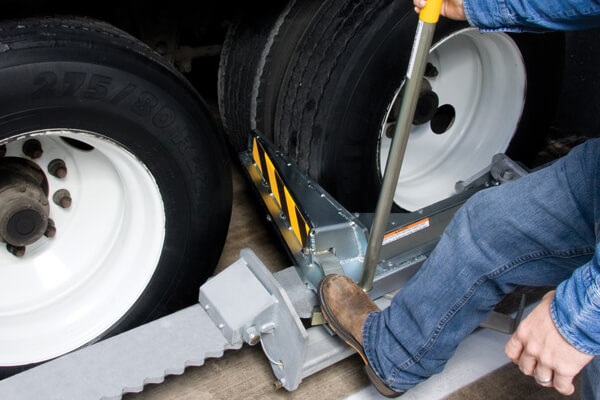
How They Work: After the trailer is properly positioned, loading platform staff use a long operating rod to manually push or pull the lever mechanism of the restraint device. This action causes the locking arm (typically a rotating hook) to extend and engage the trailer’s rear bumper. After loading is complete, the trailer is released by performing the reverse operation.
Advantages:
- Does not rely on power.
- Simple structure, easy to operate and maintain.
Disadvantages:
- Operator Dependent: Safety depends on employees performing the operation correctly and promptly each time. There is a risk of human error.
- Lower Efficiency: Manual operation is more time-consuming than button-operated systems and may slow down truck turnover.
Best For:
- Low-traffic warehouses: Handle a small number of trucks daily.
- Budget-conscious applications: When initial investment is a primary consideration.
- As an upgrade from wheel chocks: Seeking a more reliable solution than wheel chocks but with controlled costs.
Hydraulic Trailer Restraints
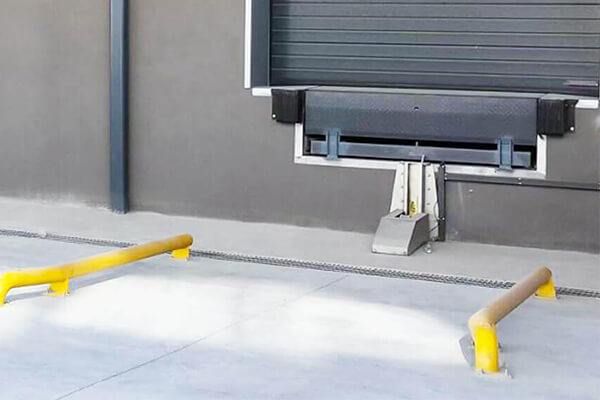
Hydraulic trailer restraint systems use hydraulic devices to automatically lock trailers in place, such as vertical truck restraints. They can quickly and securely fix trailers to dock levelers when they arrive. Users can easily operate the system via a control panel or remote control device.
Advantages:
- High degree of automation, easy to operate, no manual intervention required.
- Stable and rapid locking process, effectively improving loading and unloading efficiency.
- Reduces human error, providing higher safety.
Disadvantages:
- High initial investment, suitable for locations with high efficiency requirements.
- Requires regular maintenance of the hydraulic system, with higher maintenance costs.
Mechanical Trailer Restraints
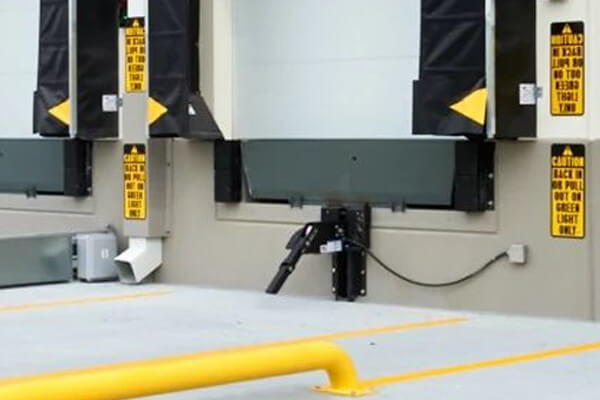
Working Principle: Mechanical trailer restraint systems typically use simple mechanical devices to secure trailers to loading dock leveler manually or mechanically. For example, the Rotating hook trailer restraint is usually equipped with a locking hook that can automatically or manually lock the trailer in place upon arrival.
Advantages:
- Relatively low cost, suitable for businesses with limited budgets.
- Simple structure, easy to operate and maintain.
Disadvantages:
- Operations are relatively cumbersome and require manual intervention.
- May not be suitable for high-frequency, large-scale loading dock leveler.
Application: Suitable for low to medium-frequency loading and unloading needs, typically used in basic logistics environments or warehouses with limited equipment budgets.
Electric Restraint System
Working Principle: Electric trailer restraint systems use electric devices to control the lifting or locking of fixed devices. Electric motors drive the latches and trailer fixed devices to securely lock the trailer in place. These systems are typically equipped with automated control systems for easy operation.
Advantages:
- Highly automated, reducing manual operations.
- Quickly and efficiently completes trailer locking, improving work efficiency.
- Can be integrated with other automated systems (such as traffic lights, sensors) to achieve intelligent management.
Disadvantages:
- Requires a stable power supply and is not suitable for environments without power or with unstable power supply.
- High initial investment.
Application: Suitable for environments requiring high automation levels, high work efficiency, and frequent use, such as large warehouses and distribution centre.
Tip: Visualize Your Options with a Comparison Table
| Feature | Manual Restraint | Mechanical Restraint | Hydraulic Restraint | Electric Restraint | Wheel-Based Restraint |
| Best For | Low-volume, budget-conscious | Moderate-volume, efficiency focus | High-volume, heavy-duty | Clean environments, energy-conscious | All trailer types, liftgates |
| Operation | Manual (Lever) | Automatic (Truck-powered) | Powered (Push-button) | Powered (Push-button) | Powered (Push-button) |
| Holding Power | Good | Very Good | Exceptional | Excellent | Excellent |
| Key Advantage | Lowest Initial Cost | Automatic Lock, No Power | Maximum Power & Speed | Clean, Low Maintenance | Universal Versatility |
Key Benefits of Investing in a Trailer Restraint System
Safety and Regulatory Compliance
Safety is the most important advantage of the trailer restraint system. It physically secures the trailer to the platform, effectively preventing accidents such as trailer creep and accidental departure.
Regulatory Requirements: The U.S. Occupational Safety and Health Administration (OSHA) explicitly requires in its regulations that ‘brakes must be applied and wheel chocks or other effective vehicle restraint measures must be used to prevent trucks or trailers from moving.’ While there is no mandatory requirement to use specific equipment, the dock restraint system is widely recognized as the ‘best practice’ that meets and exceeds this standard. Its active, reliable locking mechanism aligns far more closely with the spirit of the regulations than passive, prone-to-failure wheel chocks, giving you confidence during safety inspections.
Increased Operational Efficiency
- Reduced waiting time: Powered or automated systems reduce locking/unlocking time from several minutes to a few seconds. Drivers do not need to get out of their vehicles to place wheel chocks, and warehouse staff do not need to wait for confirmation, allowing forklifts to be put into operation more quickly.
- Faster Turnaround Times: Faster single-vehicle loading and unloading times mean your loading platform can handle more trucks daily. This directly boosts the facility’s overall throughput, enabling you to accomplish more within limited time and space constraints.
Protection of Assets and Reduced Damage
Сайт truck restraints system effectively prevents loading and unloading accidents and protects valuable equipment and cargo from damage. By reducing forklift falls, cargo damage, and equipment damage, the truck restraint ensures that your assets are better protected, reduces repair and replacement costs, and extends the service life of your facilities.
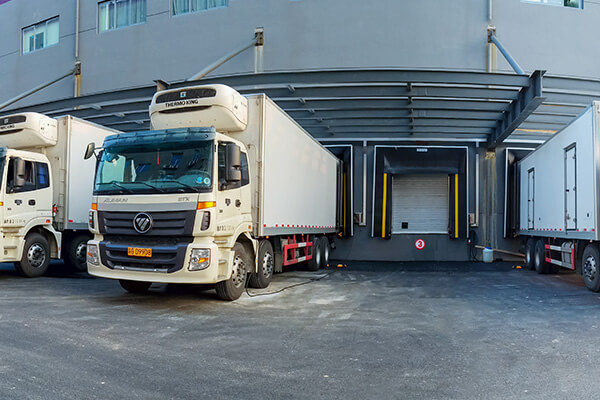
How to Choose the Right Trailer Restraint System for Your Facility
Step 1: Assess Your Dock
- Dock Design and Space: Is your loading pit-style or edge-of-dock leveler? Is there enough space and structural strength on the floor or wall where the restraint system will be installed? Different types of dock levelers have specific requirements for installation conditions.
- Daily Traffic: For low-traffic warehouses with only a few trucks per day, a manual or mechanical restraint system may be sufficient. But for distribution centers that run 24/7 and frequently, an efficient hydraulic or electric trailer restraint system can increase overall productivity.
- Loading dock leveler height: What is the range of your dock leveler height to the floor height of the visiting trailer? The equipment you choose must have enough vertical service range to ensure that it can securely lock the rear bumper beams of all different trailer heights.
Step 2: Consider Your Trailer Type
- Condition of Rear Bumper Beams: Are all trailers equipped with compliant, undamaged rear bumper beams? If so, most standard vehicle restraint systems are suitable for installation.
- Specialty Vehicles and Tailgate Lifts: Are there trucks with hydraulic tailgate lifts in your loading dock on a regular basis? Tailgates can completely block a standard RIG locking restraint system. In this case, the Wheel-Based Restraint is your most reliable and flexible option, as it locks the wheels directly, bypassing all rear-end obstacles.
3 Step: Balance Budget and ROI
- Initial Investment: Manual systems are the least expensive to purchase, while fully automated hydraulic or electric systems require a higher upfront investment.
- Long-Term Return: In terms of long-term return on investment (ROI). The value of a quality dock security device far exceeds its initial price.
- Accident Prevention: Avoid workers’ compensation and insurance rate increases due to unintentional trailer movement.
- Asset Protection: Preventing forklift falls, cargo damage, and equipment repairs that can result in significant financial losses.
- Increase Efficiency: Automated systems can significantly reduce vehicle locking and unlocking times, resulting in a significant increase in overall efficiency.
- Compliance: Ensure that your facility meets safety regulations such as OSHA and avoid costly fines for violations.
Step 4: Consider Environmental Factors
- Indoor vs. Outdoor: If the equipment is to be installed outdoors and exposed to the elements, it should be protected from corrosion and rust. Corrosion and rust resistance is critical. Choose a model that has been hot-dipped galvanized or otherwise weatherproofed.
- Climatic conditions: Are there weather extremes in your area? In cold regions, the viscosity of the hydraulic fluid may be affected, and a high-performance electric trailer restraint system may perform more consistently. In rainy or humid environments, the unit’s electrical components must have an excellent waterproof rating ( IP67).
Часто задаваемые вопросы
Q1: Are trailer restraints required by OSHA?
A: OSHA requires employers to take effective measures to prevent trucks from moving during loading and unloading. While the regulation does not specify that a specific device, the “trailer restraint system,” is widely recognized by industry and safety experts as one of the most effective and reliable ways to meet and exceed this requirement, and is far superior to traditional wheel chocks, which pose numerous safety hazards.
Q2: How long does installation take?
A: Typically, a standard trailer restraint system can be installed in a few hours by a professional installation team. We strive to minimize disruption to your daily operations. The exact time varies slightly depending on site conditions and the complexity of the chosen model.
Q3: What are the maintenance requirements?
A: To ensure that the system is always in optimum working order, we recommend regular maintenance. This typically includes cleaning and lubricating parts, checking electrical connections and fasteners, and testing all safety features. We offer detailed maintenance guidelines and a professional maintenance service program.
Q4: What if a trailer has a damaged or special type of bumper?
A: This is a very common question. If your facility experiences this on a regular basis, we highly recommend the Vertical Barrier Restraint. Because it doesn’t rely on crash bars to lock, but works by blocking the wheels, it can safely restrain almost any type of trailer, regardless of its tail structure.
Further Reading: Build a Complete Loading Dock Ecosystem
A trailer restraint is a critical safety component, but a truly safe and efficient loading dock is a complete ecosystem of integrated solutions. To further your expertise, we highly recommend exploring these related guides to master every facet of your facility’s safety.
- Типы автомобильных удерживающих устройств: Полное руководство по выбору правильной удерживающей системы для грузовиков This guide is the perfect next step, offering an even deeper dive into the specific technologies and models of truck restraints to help you compare and select the ideal solution.
- Что такое резиновые бамперы для доков? Полное руководство для начинающих Learn about the “first line of defense” for your loading dock. Understand how these essential components protect your building foundation and trailers from costly, repetitive impact damage.
- Soft Curtain Flexible Barrier: Providing Safety for loading Dock Leveler Discover an innovative solution to prevent dangerous falls from open dock positions when a trailer is not present. This guide explains how flexible barriers create a vital visual and physical guard.
- Enhancing Industrial Safety with Flexible Bollards: A Comprehensive Guide to Polymer Flexible Guardrails Extend your safety focus beyond the dock door. This comprehensive guide shows you how to use modern polymer bollards and guardrails to protect valuable equipment, racking, and pedestrian walkways throughout your facility.
